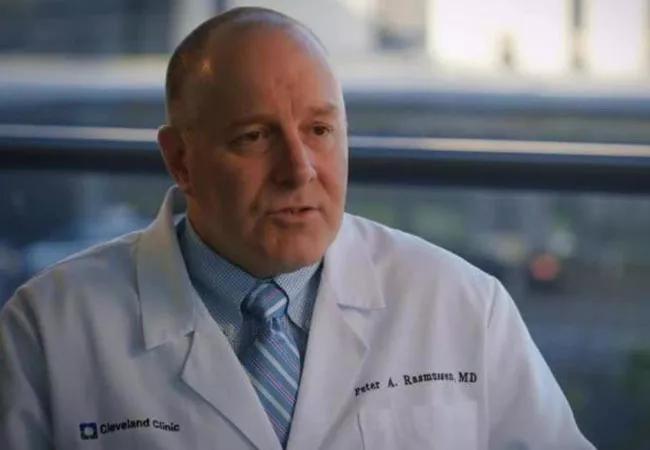A Q&A with Dr. Peter Rasmussen

Digital health has been defined as “the convergence of digital technologies with health, healthcare, living, and society to enhance the efficiency of healthcare delivery and make medicines more personalized and precise.”
Advertisement
Cleveland Clinic is a non-profit academic medical center. Advertising on our site helps support our mission. We do not endorse non-Cleveland Clinic products or services. Policy
As a pioneer in the adoption of digital health technologies, Cleveland Clinic has developed a strategic digital health portfolio to help manage the growing onslaught of technologies. Today, its Digital Health Domain includes a team of nearly 100 people working to enable caregivers across the health system with the latest technologies.
Neurosurgeon Peter Rasmussen, MD, Medical Director of Digital Health, says “To stay relevant in a world that is dominated by smartphones and tablets, physicians must change their practices.”
CQD talked to Dr. Rasmussen to learn more.
What does it take to create a successful digital strategy?
Digitalization of medical care has great challenges. To be successful, it demands an in-depth understanding of what patients and caregivers need and desire. And it requires agreement from multiple stakeholders who are working within a robust and capable digital health infrastructure. Mix in globalization and an ever-evolving healthcare landscape and the prospect can be daunting.
Over the past two years, Cleveland Clinic has been developing an enterprise digital transformation strategy and a roadmap for implementing the next phase of digital health solutions.
Can you explain the evolution in recent years?
In the last decade, we have changed the model of care by virtualizing the practice of medicine where it makes clinical and economic sense. Telemedicine-enabled virtual visits are increasing providers’ efficiency in the era of bundled payments, while providing a lower-cost and more convenient care option for many patients. Frequently, this online care reduces ED visits.
Advertisement
In noncritical situations, online second opinion consults and virtual visits have become a convenient way of conducting outpatient visits in most subspecialty areas, and it works very well for routine follow-up appointments. We are also available for on-demand urgent care needs.
Over the last three years, our virtual visits have grown exponentially. Taking a closer look at Cleveland Clinic’s Neurological Institute, our physicians went from a total of 1,660 virtual visits in 2017, up to 6,101 in 2018. This year, in the first quarter alone, we have managed 2,038 virtual visits, putting us on track for more than 80,000 virtual visits across the organization in 2019.
Virtual visits are ideal for patients coming to us from out of town for major procedures. They are used for both pre-surgery appointments and post-surgical follow ups. Virtual visit interactions are generally shorter for physicians, which greatly increases our efficiency for our practices.
Cleveland Clinic’s Express Care® Online app helps make these interactions happen. Patients simply open the app on their Apple or Android device, log in and enter an electronic waiting room. After reviewing the patient’s chart or test results, the physician “enters” the room and chats face to face with the patient through a secure connection with Skype®-like access.
What is the latest technology advance for managing chronic patients?
For patients today, it’s all about wearable and mobile devices. Giving patients these portable devices is helping them to manage their health and more easily integrate healthcare into their lives. This includes remote monitoring for any number of conditions, from obesity to hypertension to more complex diseases. Two monitors in use now are for our heart patients and our patients with chronic wounds.
Advertisement
We also offer digital scheduling via our electronic medical record (EMR) to ensure that patients can find the care they are looking for without delay. We offer MyChart self scheduling, a wait-time estimator and the ability to wait-list yourself for appointments. We have even integrated our Oscar Insurance program into the EMR.
What are you doing internally at the hospitals?
We continue to enable and engage caregivers at all levels. In-facility virtual visits are now enabling physicians to spend more time with patients and less time moving between locations. Our physicians can do inpatient virtual rounding, facility virtual visits and telestroke visits. We are also doing inpatient consulting with nurses (and all caregivers) across our health system via secure chat.
Mobile applications are ensuring that EMR data is never more than a few taps away wherever our caregivers are. We are using a set of programs to bring the electronic medical record to our caregivers wherever they are on their mobile devices.
What’s on the horizon?
We will soon be rolling out an app for Cleveland Clinic patients globally that unifies all of our online capabilities, including our electronic medical record, virtual visit capability, ED visit wait time, the find a doc tool and more. It will also be the digital hub for all connected devices, which will make it a powerful tool that connects patients to all their health needs anywhere in the world.
Any final thoughts?
We want to optimize value and deliver Cleveland Clinic quality care to all of our patients, current and future, anywhere in the world. We see digital health solutions as a world-wide “healthcare experience” revolution.
Advertisement
Leadership programs developed by Cleveland Clinic encourage innovation and create projects that have positive institutional impact. For more information on Cleveland Clinic Global Executive Education contact the team online at clevelandclinic.org/execed.
Advertisement
Advertisement

Automating routine medical coding tasks removes unnecessary barriers

Digital “tripwires” detect and respond to malicious activity, boosting cybersecurity maturity

Effective provider training strategies incorporate multi-modal delivery

Thoughtful collaboration, data-driven decisions and effective change management lead to significant savings

A thoughtfully designed program to elevate participants’ leadership potential

Clinical input is integral to technology implementation and adoption strategy

Advancing technology makes informatics expertise essential

Integrating technology is more than product delivery